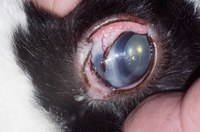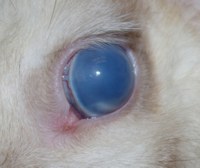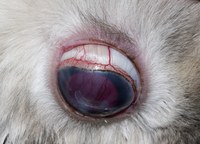A suspected melanoma in the eye
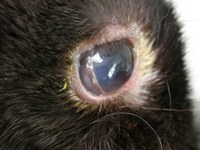
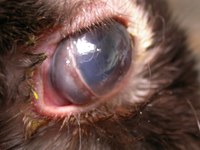
Over 10 years ago, a rabbit was brought to see me because the owner had noticed that the right eye looked strange (see above photos). The rabbit was eating normally but may have been a bit quieter than usual. Examination of the eye showed a slightly raised area of dark pigmented tissue at the limbus, which is the circular junction of the white of the eye (the sclera) with the cornea. The lesion could be seen even more clearly with the eyelid pulled back.
A tentative diagnosis of melanoma was made. This type of tumour can occur within the eye. If the tumour is malignant, removal of the eye offers the best hope of survival for the patient as is often successful because the tumour is contained. The rabbit was booked in for surgery the following day. The eye was removed and the rabbit recovered uneventfully. He eventually died from unrelated causes
Some years later, these pictures were shown to a group of veterinary ophthalmologists as an example of limbic melanoma. The chairman of the meeting was (and still is) an eminent veterinary ophthalmologist. He questioned my diagnosis of melanoma and said that the lesion could be a 'staphyloma' secondary to glaucoma. Glaucoma is a condition that is characterised by enlargement of the eyeball due to increased pressure within it. A staphyloma is a term that is used to describe an abnormal protrusion of the contents of the eye through a weak point in the eyeball. The protrusion is generally dark in colour, due to the colour of the inner structures of the eye. Glaucoma is a common cause of this weakness because enlargement of the eyeball (buphthalmos) stretches and thins the tissue especially at the limbus. Glaucoma is potentially painful and ultimately leads to loss of vision because the raised pressure in the eyeball kills the visual cells in the retina.
In rabbits, glaucoma is relatively common, especially in pedigree stock. It is often a hereditary condition that can affect one or both eyes. Breeders may refer to it as 'Blue eye' or 'Moon eye'. The cloudy blue colour of the eye is due to corneal oedema, which is one of the conditions that is associated with glaucoma. The rabbit whose eye is shown in the left was one of many affected rabbits in a colony that was used to breed rabbits to exhibit and to sell as pets. There is no universally effective medical treatment for glaucoma and, without removing the eye, there is no cure. Although, glaucoma is known to be painful, some rabbits seem to cope well, even if both eyes are affected and they are totally blind. Although removing a glaucomatous eye will relieve the pain, there are cosmetic considerations, especially if the condition is bilateral. It can be a difficult decision to make. Longstanding glaucoma is less likely to be as painful as an acute glaucoma.
Other conditions that cause an eye to bulge are common in rabbits e.g. retrobulbar abscesses or tumours. Making a diagnosis of glaucoma is important because the treatment and prognosis is different to treating an abscess or a tumour. Measuring intraocular pressure is the way that glaucoma is diagnosed in people and this is possible in rabbits. However, there are other suggestive signs that can be seen by examining the eye. An eye that feels large and tense is suggestive of glaucoma. The third eyelid is usually hidden.
Congestion of the blood vessels that supply the sclera (episcleral congestion) is another sign of raised intraocular pressure. In rabbits there is often a characteristic circular pattern of blood vessels around the cornea with one or two large vessels coming across the sclera to supply them. This pattern can be seen on the glaucomatous eye shown above (left) in comparison with a normal eye shown on the right.
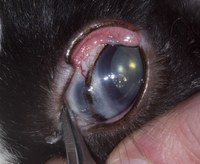
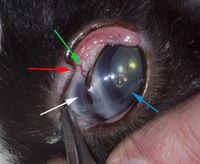
Over the last decade, I have seen several other rabbits with a pigmented area at the limbus and they have all been associated with glaucoma. The latest case is shown above. The white arrow goes to the pigmented area. The green arrow goes to a congested blood vessel in the sclera. The blue arrow goes to horizontal lines in the front of the eye. These are 'Haab's striae' which are linear breaks in the lining of the cornea (Descemet's membrane) and are a feature of glaucoma, again caused by stretching of the outer layers of the eye. The red arrow goes to an unrelated eye problem, but one that is common in pet rabbits. It is an extra flap or notch of abnormal eyelid (eyelid dysplasia) that can roll in and cause irritation to the eye. In this case, the eyeball was large enough to prevent this happening.
In this last case, the eye was removed. There were two reasons for this. Firstly, the area of the eye that is pigmented is a common site for melanoma to occur, so the diagnosis could not be ruled out easily. Melanomas grow inside the eye and are not obvious until they are large enough to protrude from behind the iris. The longer they are present in the eye the more likely they are to spread to the rest of the body. Secondly, the rabbit seemed depressed and unhappy. His demeanour improved with painkillers. After his eye was removed, he was much happier and livelier. The eye was sent for histology, which confirmed there was no melanoma but there was glaucoma. It is very likely that this was causing the pain.

